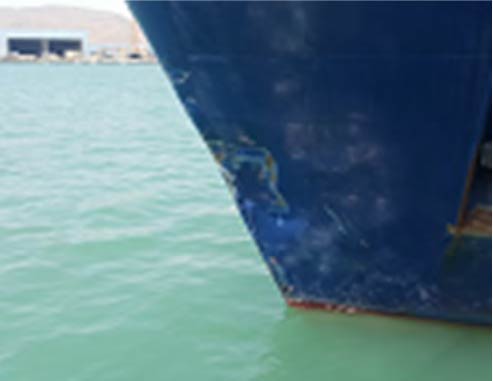Collision between vessels
A member has reported an incident in which there was a collision between a survey vessel and a pipe-carrying vessel. The incident occurred during vessel manoeuvring inside an anchor pattern. A survey vessel was instructed by a pipe laying barge to proceed towards the pipe-carrying vessel which was tied up alongside the barge, and then to moor alongside to complete a crew change. Upon entry of the 500m zone, the survey vessel was travelling at a speed of 4 knots maintaining a direct heading toward the barge. This was necessary because of the location of the mooring lines for the barge anchor pattern.
The Chief Officer attempted to slow down and change the heading on a distance of about 200m from the moored pipe-carrying vessel but identified the inability to alter the azimuth direction. The vessel Master, on taking command, attempted to alter the course of the vessel using the bow thrusters but to no effect. The survey vessel subsequently made contact with the pipe-carrying vessel causing some damage.


Our member’s investigation noted the following:
- There was a loss of control over both azimuth thrusters:
- Potentially the autopilot system engaged due to some mechanical failure or to human error
- Neither the manufacture’s representatives or service engineer, nor the investigation team could advise on the definite cause;
- A potential contributory factor was design deficiency:
- One single switch controlled both ‘independent’ steering systems
- Autopilot option overrode both azimuth thrusters, with no automatic disengagement available
- When the autopilot is engaged it is not visually apparent to the operator
- The ergonomics of the bridge console layout could potentially result in an alternative identical switch in the same vicinity as the autopilot switch (in this case, the gyro selector) being operated;
- The 500m zone vessel speed requirements were not followed – despite the requirement for a maximum vessel speed of 2 knots in this particular safety zone, a speed of 4 knots was maintained for most of the distance, with further and possibly consequent failure to stop the vessel in close proximity to barge (around 200m away);
- Company requirements for vessel heading were not followed – procedures forbade the use of offshore installations as navigational waypoints. The bridge crew on the survey vessel steered directly towards the barge;
- The incident was not reported to the company ashore in a timely way or through appropriate and proper channels.
Members may wish to refer to the following incidents (search word: collision):
Safety Event
Published: 3 October 2016
Download: IMCA SF 25/16
IMCA Safety Flashes
Submit a Report
IMCA Safety Flashes summarise key safety matters and incidents, allowing lessons to be more easily learnt for the benefit of all. The effectiveness of the IMCA Safety Flash system depends on Members sharing information and so avoiding repeat incidents. Please consider adding [email protected] to your internal distribution list for safety alerts or manually submitting information on incidents you consider may be relevant. All information is anonymised or sanitised, as appropriate.
IMCA’s store terms and conditions (https://www.imca-int.com/legal-notices/terms/) apply to all downloads from IMCA’s website, including this document.
IMCA makes every effort to ensure the accuracy and reliability of the data contained in the documents it publishes, but IMCA shall not be liable for any guidance and/or recommendation and/or statement herein contained. The information contained in this document does not fulfil or replace any individual’s or Member's legal, regulatory or other duties or obligations in respect of their operations. Individuals and Members remain solely responsible for the safe, lawful and proper conduct of their operations.
